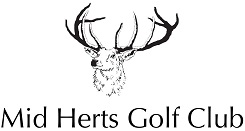
Mid Herts Golf club
Mid Herts Golf Club

Created by intelligentgolf version 10.1.2.

Mid Herts Golf Club
Lower Gustard Wood, Lamer Lane, Wheathampstead,
Hertfordshire, AL4 8RS
Tel: 01582 832242
Email: gm@midhertsgolfclub.co.uk